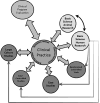Activity-Based Therapy: From Basic Science to Clinical Application for Recovery After Spinal Cord Injury
- PMID: 28628595
- PMCID: PMC5477660
- DOI: 10.1097/NPT.0000000000000184
Activity-Based Therapy: From Basic Science to Clinical Application for Recovery After Spinal Cord Injury
Abstract
Background and purpose: Collaboration between scientists and clinicians effectively accelerated translation of scientific evidence for activity-based therapies (ABTs) into rehabilitation. This article addresses the basic scientific findings of activity-dependent plasticity that led to locomotor training, an ABT, and its principles to advance recovery in adult and pediatric populations with spinal cord injury (SCI). Expansion to new therapies based on these common principles is highlighted, for example, epidural stimulation. The article also describes a recently developed measure, the Neuromuscular Recovery Scale (NRS), and its psychometric properties.
Summary of key points: Locomotor training has led to recovery of walking in some individuals with motor-incomplete SCI even years after injury. Recent studies resulted in individuals with motor-complete SCI regaining some voluntary movements and standing in the presence of epidural stimulation. The level of success for locomotor training and epidural stimulation appears dependent on spinal networks maintaining the appropriate central state of excitability for the desired task. As these new advances in restorative therapies required an outcome measure that measured performance without compensation, the NRS was developed. The NRS has strong psychometric properties in adults, and a pediatric version is under development. Application of locomotor training in children is still novel. Preliminary evidence suggests that locomotor training can improve trunk control and also foster participation in children with chronic SCI.
Recommendations for clinical practice: ABTs may effectively promote neuromuscular recovery and improve function and participation in adults and children post-SCI. Evaluation of outcomes with valid measures, such as the NRS, is necessary to document the ability to perform functional tasks and to assess progress as function improves.
Conflict of interest statement
Conflicts of Interest: Drs. Behrman, Ardolino and Harkema are founders of NeuroRecovery Ed Inc.
Susan J Harkema, co-founder Power NeuroRecovery
Figures



References
-
- Harkema SJ, Schmidt-Read M, Behrman AL, Bratta A, Sisto SA, Edgerton VR. Establishing the NeuroRecovery Network: multisite rehabilitation centers that provide activity-based therapies and assessments for neurologic disorders. Arch Phys Med Rehabil. 2012 Sep;93(9):1498–507. doi: 10.1016/j.apmr.2011.01.023. Epub 2011 Jul 20. - DOI - PubMed
-
- Harkema S, Gerasimenko Y, Hodes J, et al. Effect of epidural stimulation of the lumbosacral spinal cord on voluntary movement, standing, and assisted stepping after motor complete paraplegia: A case study. Lancet. 2011 Jun 4;377(9781):1938–47. doi: 10.1016/S0140-6736(11)60547-3. Epub 2011 May 19. - DOI - PMC - PubMed
-
- Collins DF. Central contributions to contractions evoked by tetanic neuromuscular electrical stimulation. Exerc Sport Sci Rev. 2007 Jul;35(3):102–9. Review. - PubMed
Publication types
MeSH terms
Grants and funding
LinkOut - more resources
Full Text Sources
Other Literature Sources
Medical
Research Materials

